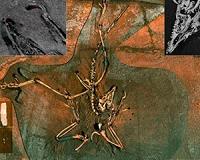| . |  |
. |
Philadelphia PA (SPX) May 20, 2010 Researchers in the Department of Biochemistry and Molecular Biology at Thomas Jefferson University have found that the level of a single protein in the tiny roundworm C. elegans determines how long it lives. Worms born without this protein, called arrestin, lived about one-third longer than normal, while worms that had triple the amount of arrestin lived one-third less. The research also showed that arrestin interacts with several other proteins within cells to regulate longevity. The human version of one of these proteins is PTEN, a well-known tumor suppressor. The study, to be published in the online edition of the Journal of Biological Chemistry, was chosen by the journal as the "Paper of the Week" - considered in the top one percent of published articles. Because most proteins in worms have human counterparts, these findings may have relevance to human biology and the understanding of cancer development, said Jeffrey L. Benovic, Ph.D., professor and chair of the department. "The links we have found in worms suggest the same kind of interactions occur in mammals although human biology is certainly more complicated. We have much work to do to sort out these pathways, but that is our goal," said Dr. Benovic. Researchers use the roundworm as a model because it offers a simple system to study the function of genes and proteins that are relevant to human biology. The worm, for example, has one arrestin gene, whereas humans have four. Worms only have 302 neurons compared to the 100 billion or so in the human brain. In addition, their short lifespan of two to three weeks allows for timely observation of effects on longevity. Dr. Benovic and the study's first author, Aimee Palmitessa, Ph.D., a postdoctoral research fellow, studied signaling pathways activated by G protein-coupled receptors. These receptors bind to all kinds of hormones, sensory stimuli (such as light, odorants and tastants), neurotransmitters, etc., which then activate a cascade of signals inside the cell. They regulate many physiological processes and are the target for about half of the drugs currently on the market. "When it comes to receptors, worms are actually more complex," said Dr. Benovic. "Humans have about 800 different kinds of G protein-coupled receptors while the worm has about 1,800. It relies upon these receptors to respond to sensory stimuli as well as various neurotransmitters and hormones." Arrestins were initially found to turn off the activation of G protein-coupled receptors inside cells. "Their name comes from the fact that they arrest the activity of receptors, so the worm offers a good way to study how its single arrestin protein interacts with protein receptors," says Dr. Benovic. Two of the four arrestins that humans have are devoted to regulating receptors that respond to visual stimuli while the other two regulate most other receptors. In this study, Dr. Palmitessa deleted the single arrestin gene in worms to see what would happen, and found, to her surprise, that these worms lived significantly longer. She also found that over-expressing arrestin in worms shortened their lifespan. "A little less arrestin is good - at least for worms," Dr. Benovic reported. This isn't the first discovery made regarding longevity in worms. Researchers have already found that activity of the insulin-like growth factor-1 (IGF-1) receptor can influence longevity in worms - a finding that has also been replicated in fruit flies, mice, and humans. Like arrestin, a little less IGF-1 receptor activity is good, Dr. Benovic explained. Further research has shown that caloric restriction can also reduce IGF-1 receptor activation and, conversely, over-expression of the IGF-1 receptor is found in some human cancers. In this study, Dr. Benovic and Dr. Palmitessa dug a little deeper and found that in the worms, arrestin interacted with two other proteins that play a critical role in its ability to regulate longevity. One of those proteins is the tumor suppressor PTEN; mutations in PTEN are involved in a number of different cancers. Dr. Benovic said the connection between human arrestin and PTEN is not clear. "We don't know at this point if human arrestins regulate PTEN function or if anything happens to arrestin levels during the development of cancer," he said. "Do increasing levels turn off more PTEN, thus promoting cancer, or do levels decrease and allow PTEN to be more active? "If it turns out to be the first scenario - that increasing amounts of arrestin turn off the tumor suppressor activity of PTEN, then it may be possible to selectively inhibit that process," he says. "We have some interesting work ahead."
Share This Article With Planet Earth
Related Links Thomas Jefferson University Darwin Today At TerraDaily.com
 X-rays Reveal Chemical Link Between Birds And Dinosaurs
X-rays Reveal Chemical Link Between Birds And DinosaursMenlo Park, CA (SPX) May 19, 2010 Researchers have found that a 150 million year old "dinobird" fossil, long thought to contain nothing but fossilized bone and rock, has been hiding remnants of the animal's original chemistry. Using the bright X-ray beam of the Stanford Synchrotron Radiation Lightsource, located at the Department of Energy's SLAC National Accelerator Laboratory, an international team of paleontologists, ge ... read more |
|
| The content herein, unless otherwise known to be public domain, are Copyright 1995-2010 - SpaceDaily. AFP and UPI Wire Stories are copyright Agence France-Presse and United Press International. ESA Portal Reports are copyright European Space Agency. All NASA sourced material is public domain. Additional copyrights may apply in whole or part to other bona fide parties. Advertising does not imply endorsement,agreement or approval of any opinions, statements or information provided by SpaceDaily on any Web page published or hosted by SpaceDaily. Privacy Statement |